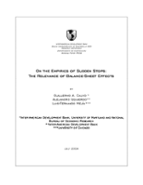On the Empirics of Sudden Stops: The Relevance of Balance-Sheet Effects
Date
Jul 2004
Using a sample of 32 developed and developing countries we analyze the empirical characteristics of Sudden Stops in capital flows and the relevance of balance-sheet effects in the likelihood of their occurrence. We find that large real exchange rate (RER) fluctuations accompanied by Sudden Stops are basically an emerging market (EM) phenomenon. Sudden Stops seem to come in bunches, grouping together countries that are different in many respects. However, countries are similar in that they remain vulnerable to large RER fluctuations. This may be the case because countries are forced to make large adjustments in the absorption of tradable goods, and/or because the size of dollar liabilities in the banking system (i.e., domestic liability dollarization, or DLD) is large. Openness, understood as a large supply of tradable goods that reduces leverage over the current account deficit, in combination with DLD, is a key determinant of the probability of Sudden Stops. The relationship between Openness and DLD in the determination of the probability of Sudden Stops is highly non-linear, implying that the interaction of high current account leverage and high dollarization may be a dangerous cocktail.



